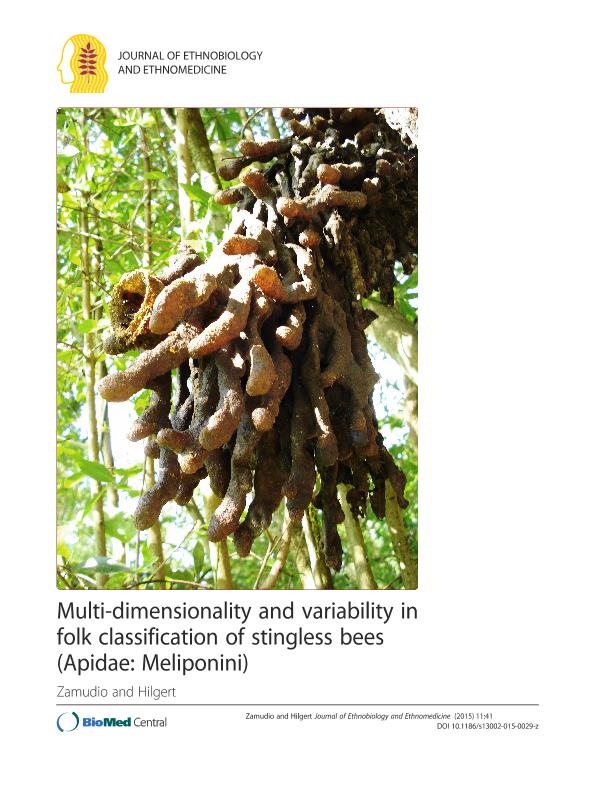Mostrar el registro sencillo del ítem
dc.contributor.author
Zamudio, Fernando

dc.contributor.author
Hilgert, Norma Ines

dc.date.available
2018-02-15T19:40:39Z
dc.date.issued
2015-05
dc.identifier.citation
Zamudio, Fernando; Hilgert, Norma Ines; Multi-dimensionality and variability in folk classification of stingless bees (Apidae: Meliponini); BioMed Central Ltd.; Journal of Ethnobiology and Ethnomedicine; 11; 1; 5-2015
dc.identifier.issn
1746-4269
dc.identifier.uri
http://hdl.handle.net/11336/36583
dc.description.abstract
Background: Not long ago Eugene Hunn suggested using a combination of cognitive, linguistic, ecological and evolutionary theories in order to account for the dynamic character of ethnoecology in the study of folk classification systems. In this way he intended to question certain homogeneity in folk classifications models and deepen in the analysis and interpretation of variability in folk classifications. This paper studies how a rural culturally mixed population of the Atlantic Forest of Misiones (Argentina) classified honey-producing stingless bees according to the linguistic, cognitive and ecological dimensions of folk classification. We also analyze the socio-ecological meaning of binomialization in naming and the meaning of general local variability in the appointment of stingless bees. Methods: We used three different approaches: the classical approach developed by Brent Berlin which relies heavily on linguistic criteria, the approach developed by Eleonor Rosch which relies on psychological (cognitive) principles of categorization and finally we have captured the ecological dimension of folk classification in local narratives. For the second approximation, we developed ways of measuring the degree of prototypicality based on a total of 107 comparisons of the type "X is similar to Y" identified in personal narratives. Results: Various logical and grouping strategies coexist and were identified as: graded of lateral linkage, hierarchical and functional. Similarity judgments among folk taxa resulted in an implicit logic of classification graded according to taxa's prototypicality. While there is a high agreement on naming stingless bees with monomial names, a considerable number of underrepresented binomial names and lack of names were observed. Two possible explanations about reported local naming variability are presented. Conclusions: We support the multidimensionality of folk classification systems. This confirms the specificity of local classification systems but also reflects the use of grouping strategies and mechanisms commonly observed in other cultural groups, such as the use of similarity judgments between more or less prototypical organisms. Also we support the idea that alternative naming results from a process of fragmentation of knowledge or incomplete transmission of knowledge. These processes lean on the facts that culturally based knowledge, on the one hand, and biologic knowledge of nature on the other, can be acquired through different learning pathways.
dc.format
application/pdf
dc.language.iso
eng
dc.publisher
BioMed Central Ltd.
dc.rights
info:eu-repo/semantics/openAccess
dc.rights.uri
https://creativecommons.org/licenses/by-nc-sa/2.5/ar/
dc.subject
Folk Classifications
dc.subject
Local Variability
dc.subject
Culturally Mixed Population
dc.subject
Prototypicality
dc.subject
Binomiality
dc.subject.classification
Otras Ciencias Biológicas

dc.subject.classification
Ciencias Biológicas

dc.subject.classification
CIENCIAS NATURALES Y EXACTAS

dc.title
Multi-dimensionality and variability in folk classification of stingless bees (Apidae: Meliponini)
dc.type
info:eu-repo/semantics/article
dc.type
info:ar-repo/semantics/artículo
dc.type
info:eu-repo/semantics/publishedVersion
dc.date.updated
2016-11-17T16:28:01Z
dc.journal.volume
11
dc.journal.number
1
dc.journal.pais
Reino Unido

dc.journal.ciudad
Londres
dc.description.fil
Fil: Zamudio, Fernando. Consejo Nacional de Investigaciones Científicas y Técnicas. Centro Científico Tecnológico Córdoba. Instituto Multidisciplinario de Biología Vegetal (p); Argentina
dc.description.fil
Fil: Hilgert, Norma Ines. Consejo Nacional de Investigaciones Cientiâficas y Tecnicas. Centro Cientifico Tecnologico Nordeste. Instituto de Biologia Subtropical. Instituto de Biologia Subtropical - Nodo Puerto Iguazu; Argentina
dc.journal.title
Journal of Ethnobiology and Ethnomedicine
dc.relation.alternativeid
info:eu-repo/semantics/altIdentifier/url/http://www.ethnobiomed.com/content/11/1/41
dc.relation.alternativeid
info:eu-repo/semantics/altIdentifier/doi/http://dx.doi.org/10.1186/s13002-015-0029-z
Archivos asociados
